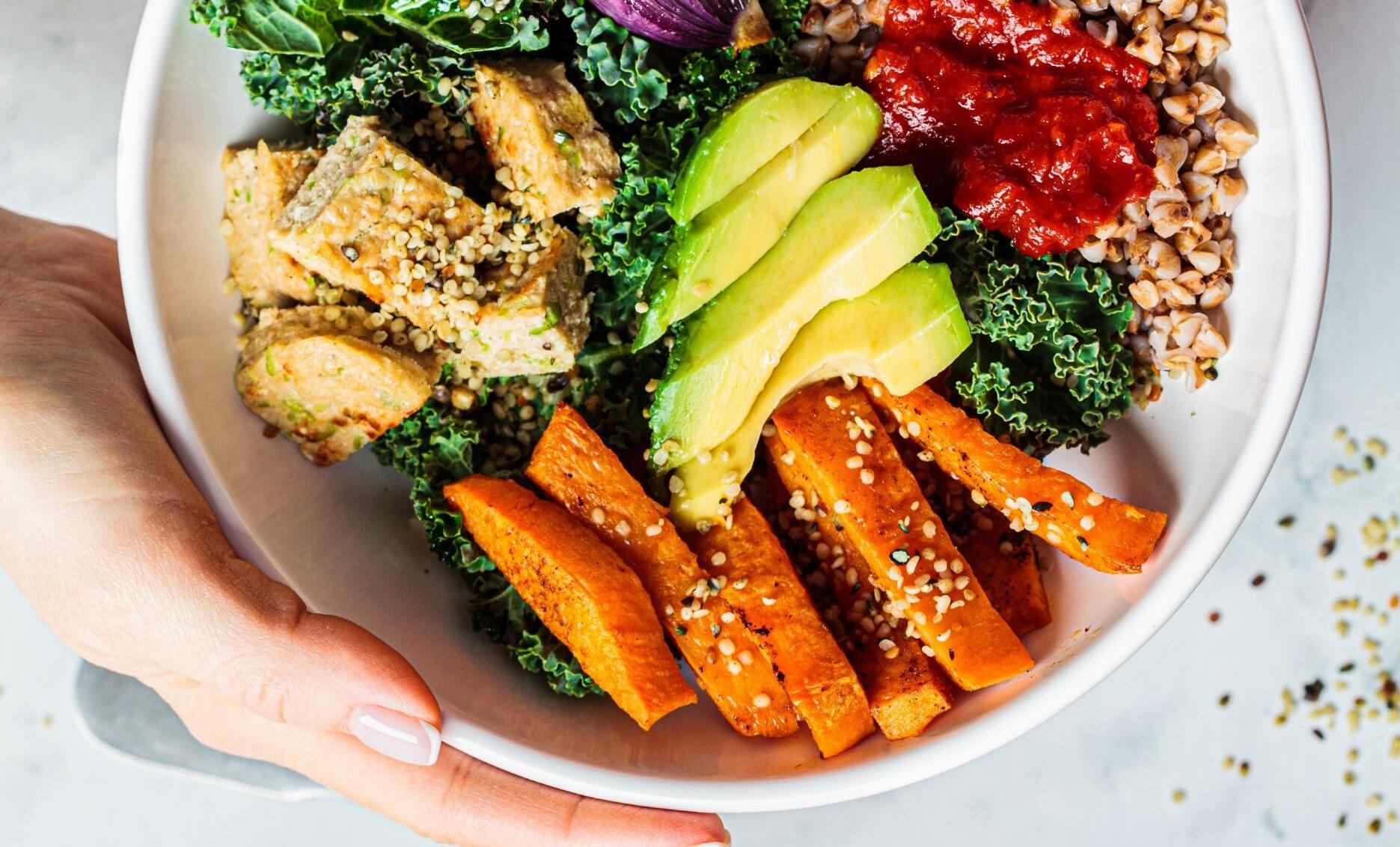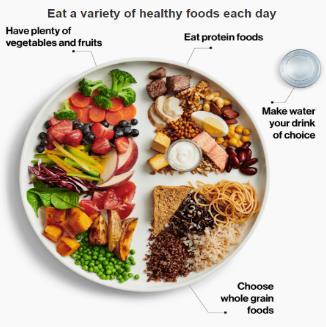Nourished Aging Toolkit


for Special Diets










In 2019, Health Canada released an updated version of CFG for Canadians to use as a tool to help make healthy food choices. Healthy Eating recommendations include:
• Focusing on the proportions of food to build a healthy plate (i.e., ¼ whole grains, ¼ protein foods, ½ fruits vegetables)2
• Eating plenty vegetables and fruits, whole grains, and protein foods (choose plant-based protein more often)
• Limiting highly processed foods
• Using food labels and being more aware of marketing messages on packaged foods
• Promoting water as the drink of choice with other options such as low-fat milk, unsweetened fortified milk alternatives, and unsweetened tea and coffee2




Food Behaviours
CFG also recommendations for food behaviours including:
• Being more mindful of your eating habits
• Cooking more often
• Enjoying your food
• Eating meals with others



The Menu Planning in Long Term Care Guidelines (2020) incorporates key principals of CFG to meet residents’ overall nutritional requirements in LTC. There are menu considerations that can be applied to a retirement menu. These include:
• Offering a variety of desserts daily including nutrient rich desserts3
• Including plant-based protein entrees at least twice per week or based on documented preferences of resident population3
• Ensuring that a minimum of 2000 ml beverages per day (both nutrient-containing and nonnutritive) at and between meals3
• Providing a variety of dairy and non-dairy calcium-fortified plant-based alternatives in adequate servings to meet calcium requirements3
• Including a variety of fruit in various forms (fresh, frozen, canned) 3
• Primarily choosing whole grain foods unless changed based on documented preferences of the resident population3
• Considering the cultures/ethnicities of the resident population and including appropriate cultural foods on the menu3
• Choose nutrient-dense foods that are easily consumed, taking into consideration common eating related barriers (e.g., poor oral health, low appetite, early satiety, fatigue, taste and sensory changes) 3

Nutrient Function
Vitamin B6
Vitamin B12
Vitamin D
Calcium
• Maintain a healthy immune system
• Needs increase after the age of 50
• Maintain nerve function
• Up to 30% of older adults above the age of 50 have difficulties absorbing B12 due to poor diet or decrease in stomach acid
• Help body absorb calcium to maintain healthy bones and teeth
• Maintain function of muscles, nerves, and immune system
• Help maintain strong bones
• Potatoes, beans, meat, chicken, fish, bananas
• Meat, fish, poultry, eggs, dairy products
Male >70 years: 1.7 mg
Female >70 years: 1.5 mg
Male and Female >70 years: 2.4 mcg
Iron
• Used to create blood cells that carry oxygen throughout the body
• Required for growth, development, and formation of hormones
• Milk, eggs fish, fortified beverages
Male and Female 51-70 years: 600 IU
Male and Female >70 years: 800 IU
• Dairy products, fortified beverages, almonds
• Meat, fish, poultry, eggs, whole grain breads and cereals
Male 51-70 years: 1000 mg
Females 51-70 years: 1200 mg
Male and Female >70 years: 1200 mg
Male and Female >70 years: 8 mg
**Please note that following CFG can help you meet your nutrient requirements, however, you may require multivitamin if your intake is low or your food choices are not nutrient dense. Please ensure that you are assessed by a registered dietitian and medical team to confirm that you receive appropriate dietary interventions based on your needs

Food texture modification is often required for individuals who develop chewing and/or swallowing difficulties as a result of an incident, disease process, or natural aging. Tolerance to texture is very individualized and therefore, it is likely that some generally accepted practices may not be acceptable or appropriate for every individual.
• Normal, everyday food of various textures that are developmentally and age appropriate.
• Food may be of a range of sizes.
• Any method may be used to eat these foods.
• Foods that are hard, tough, chewy, fibrous, stringy, dry, crispy, crunchy or have crumbly bits are allowed. Foods may include pips, seeds, pith inside skin, husks, or bones. Foods including “dual consistency" or “mixed consistency” are allowed.
• Foods that are easy to chew
• Designed primarily for people with poor dentition; however, it may be used for people with other physical conditions.
Soft/Diced
Meat
• Mixed consistencies, for example, cereal and milk or soup with grains are tolerated on this texture
• Foods may be naturally soft, cooked, or cut into small pieces. Bread products may contain small amounts of nuts, seeds, or dried fruit.
• Foods that are moist, soft, and require little or no chewing.
• Gravy or sauce is mixed with minced meats to easily be formed into a bolus
• Foods are soft, easy to swallow and must be easily mashed with a fork
• Mixed consistencies are tolerated on this texture
• Bread products without nuts or seeds are served without modification. Coarse textures and nuts are avoided
• Provides meats that may be minced, ground, or mashed in a moist form that require little or no chewing
• No other foods are modified or restricted in this texture
• Foods that have no lumps, are not sticky and have no separate thin liquids.
• Chewing is not required
• Foods are usually eaten with a spoon (a fork if possible)
• Foods cannot be drunk from a cup or sucked through a straw
• Foods will fall off a spoon in a single spoonful when tilted and continues to hold shape on a plate
• Foods can be piped, layered, or molded on a plate.
• Foods in forms that are conducive to self-feeding without utensils
• Goal is to maintain nutritional status and to foster independent feeding for individuals who have limited use of eating utensils or may refuse to use adaptive equipment
• Foods are easy to pick up with the fingers
• Fruits and vegetables are served drained or replaced with a fresh cut up version
• Meats are bite size and gravy, or sauce is served on the side for dipping
*Always consult with your Registered Dietitian, Speech Language Pathologist, or Primary Care Professional before changing or modifying a person’s diet texture or fluid consistency to reduce the risk of complications

Fluid consistency modification is required for individuals who are at risk for aspiration on thin liquids. Foods and beverages which are considered thin liquids at room temperature (water, milk, gelatin, ice cream) need to be thickened to the appropriate viscosity before service or substituted with an appropriate alternative.
There is a wide variety of thickeners on the market, and each type possesses unique properties in terms of thickening ability. Several factors can influence the outcome of a thickened liquid such as fluid type, temperature, concentration, acidity, mixing time and method, and holding time of the food or liquid being thickened.
Regular/Thin Fluids
Slightly Thick
Nectar Thick Fluids/Mildly Thick
• The Regular/Thin Liquid Fluid Type is for individuals without any fluid consistency limitations
• Fluids should flow quickly like water and should be easily consumed through any type of straw, cup, or nipple as appropriate for skill level and age
• This fluid type is characterized as thicker than water and will require a little more effort to drink than thin liquids
• Slightly Thick fluids will flow through a straw, syringe, teat/nipple. Note: This fluid consistency is not managed at Sysco Synergy Tech Suite® Database
• The Nectar Thick/Mildly Thick Fluid Type is a liquid that flows quickly off a spoon and is able to sipped from a cup
• It requires effort to drink this thickness through standard bore straws (standard bore straw = 0.209 inch or 5.3 mm diameter)
• Cannot be piped, layered or molded on a plate or eaten with a fork
Honey Thick
Fluids/Moderately Thick
Pudding Thick
Fluids/Extremely Thick
• The Honey Thick/Moderately Thick Fluid Type is a liquid that can be drunk from a cup, eaten with a spoon and requires some effort to suck through a standard or wide bore straw (wide bore straw = 0.275 inch or 6.9 mm)
• This thickness is smooth in texture with no ‘bits’ (lumps, fibers, bits of shell or skin, husk, particles of gristle or bone)
• Cannot be piped, layered, or molded on a plate or eaten with a fork
• The Pudding Thick/Extremely Thick Fluid Type is a liquid that needs to be consumed with a spoon and is too thick to drink or sip through a straw
• This thickness is not sticky, has no lumps and liquid must not separate from solids
• This thickness will fall off a spoon in a single spoonful when tilted and continues to hold shape on a plate
• It can be piped, layered or molded on a plate.
• Fluid Substitutes Grid for Fluid Restrictions is not managed within the Sysco Synergy Tech Suite Database, because this is considered a completely person-centered action
Fluid Restrictions
• It is best practice to modify the people profile according to a person’s individual preferences to carry out fluid restriction orders.
**NOTE: Thicken liquids using thickener according to the product's preparation instructions. The amount of thickener needed may vary depending on type of liquid, portion size and thickening product. Liquids will thicken differently depending on type, concentration, mixing method, and temperature**


Looking for more reliable information on the topics discussed in this toolkit? Check the resources below:

Canada's Food Guide
Canadian Society of Nutrition Management
Celiac Canada
Diabetes Canada
Dietitians of Canada
FODMAP Diet – Monash University
Health Canada
Heart and Stroke Foundation
IDDSI
Kidney Foundation
Ontario Seniors Nutrition & Advocacy Committee (OSNAC) & Food & Nutrition Advisory Team (FNAT)
Research Institute for Aging
Seasons Care